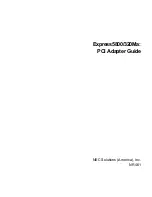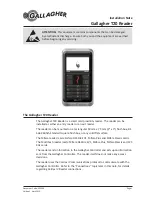
15
May ’00
Chapter 2. Commands
2.3.3
CLEAR Command
Regardless of the current transponder mode, the ASCII character C erases the iden-
tification buffer used in NORMAL mode and sets the ID counter used in GATE mode
to zero. When this task has been performed, the TIRIS reader sends back the ASCII
character C, carriage return and line feed.
The CLEAR command can be used in the same way for both TIRIS reader modes.
Example:
Comment
PC --> Reader:
C
Initiates Clear - command
Reader --> PC:
C<CR><LF>
2.3.4
READOUT BUFFER Command
The ASCII character B causes the TIRIS reader to transmit the ASCII character B
and the content of the buffer (used in NORMAL mode, see section 1.3.2) followed by
carriage return and line feed to the PC. If the buffer is empty, the TIRIS reader
sends back the ASCII character B, carriage return and line feed.
Example: (ID is buffered)
Comment
PC --> Reader:
B
Initiates Readout Buffer - command
Reader --> PC:
B10M 01 0000 0000000000000001<CR><LF>
Example: (no ID is buffered)
PC --> Reader:
B
Reader --> PC:
B<CR><LF>
2.3.5
I/O STATUS Command
The ASCII character J causes the TIRIS reader to transmit the current status of the
four lower I/O and the four higher I/O lines. The result of this function depends on the
configuration of the I/O port lines. During the manufacturing process, the TIRIS read-
er is configured so that I/O lines 0 to 3 are set to input while I/O lines 4 to 7 are set
to output. This configuration can be changed using the TIRIS Reader Manager, the
new setting is then used as default.
When the TIRIS reader receives the command character J it echoes it back to the
PC together with two ASCII characters which represent the status of the input and
output lines (hexadecimally coded) followed by carriage return and line feed.
The first character after the J represents the status of the I/O lines 0 to 3. Table 2
shows the relationship between the character and the status of the lines.
















































